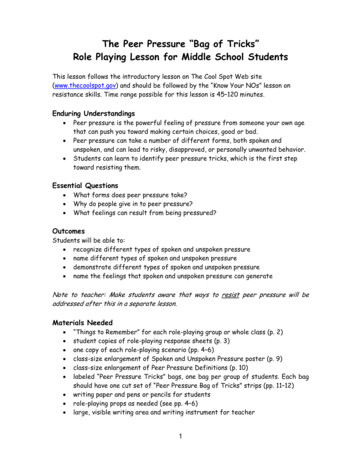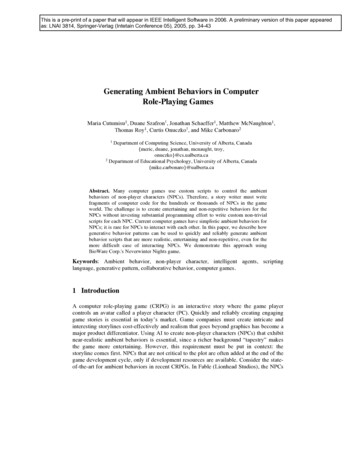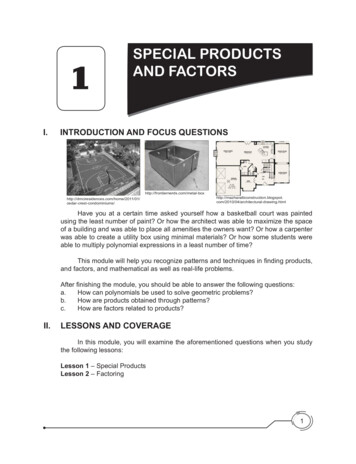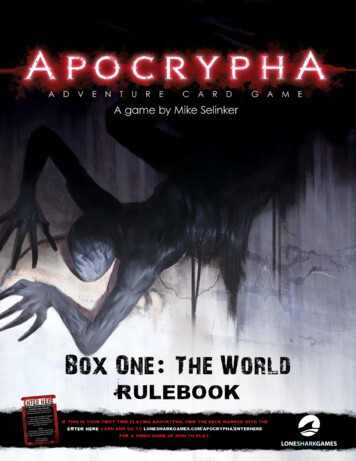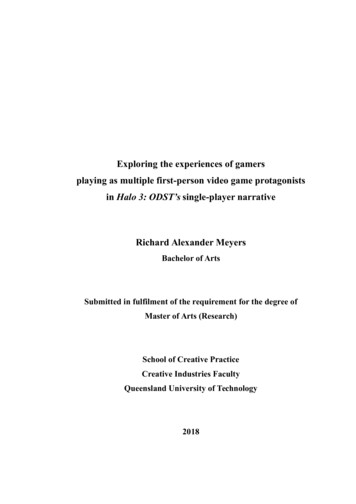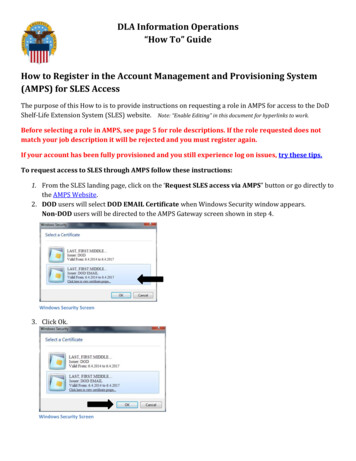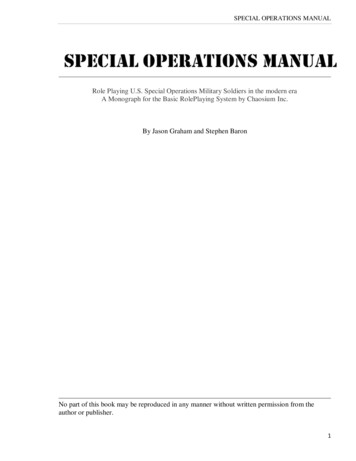
Transcription
SPECIAL OPERATIONS MANUALRole Playing U.S. Special Operations Military Soldiers in the modern eraA Monograph for the Basic RolePlaying System by Chaosium Inc.By Jason Graham and Stephen BaronNo part of this book may be reproduced in any manner without written permission from theauthor or publisher.1
SPECIAL OPERATIONS MANUAL“We sleep soundly in our beds because rough men stand ready in the night to visit violenceon those who would do us harm.”This book is dedicated to the proud men and women of the U.S. Military2
SPECIAL OPERATIONS MANUALCONTENTSINTRODUCTION – 4ARMY RANGERS – 6ARMY SPECIAL FORCES – 8NAVY SEALS – 10MARINE CORPS MARSOC – 12ARMY DELTA FORCE – 14NAVY DEVGRU – 16AIR FORCE PARARESCUE – 18PRIVATE MILITARY CONTRACTOR – 20CIA S.O.G. – 22UNITS FROM OTHER COUNTRIES - 24SKILLS – 28OFFICER SCHOOL – 30ARMOR – 31EQUIPMENT – 32WEAPONS – 33CHARACTER SHEET - 34MISSION BRIEFINGS – 36SCENARIO SEEDS - 39MEDAL OF HONOR RECIPIENTS – 40RECOMMENDED READING – 46RECOMMENDED VIEWING – 473
SPECIAL OPERATIONS MANUALINTRODUCTIONSpecial Operations soldiers are a uniquebreed. Determined, highly intelligent andspecially trained problem solvers who trainconstantly to risk their lives protectingcitizens who will never know who they are.These brave men, known as “Operators” donot expect parades for their service, in fact,they know that, should the worst happen, noteven their loved ones will be given details oftheir final mission. This selfless sense ofduty is only a small part of what makesthese operators ‘special’.Unconventional warfare is a term that isoften associated with what the SpecialOperations Soldier is designed for but whatexactly does that cover? Essentially, theseoperators specialize in all forms of warfarenot covered by the standard definition ofwar, which is a pretty wide umbrella.Small teams of highly trained expertscovertly operating behind enemy lines withlittle to no support is what most of us thinkof when we imagine a special operationsmission, however this is only a smallfraction of the actual duties andresponsibilities that these soldiers perform.Training military forces of other countries,establishing infrastructure in war torn thirdworld areas, relief missions to naturaldisaster stricken nations are only a few ofthe many ‘benign’ services that theyperform. Direct action against enemy forces,overtaking strategic locations such asrunways and hospitals, intelligencegathering, hostage rescue, counterintelligence and counter terrorism efforts aremore of the ‘active’ duties that these highlyskilled soldiers are capable of.The purpose of the Special OperationsManual for Chaosium’s Basic Role Playingsystem is to provide keepers and players theopportunity to utilize these extreme soldiersin any situation they can imagine. Thismanual will provide all of the details andinformation needed to include Operators in4the most realistic way possible within theconfines of the BRP system.This supplement is intended for an actionoriented campaign where the extra weaponsand combat skills will be not only desirablebut essential. The characters outlined hereshould be far above normal humancharacters in almost every aspect, combiningthe physical prowess of Olympic levelathletes and the problem solving and criticalthinking skills of a private investigator or acompetitive chess player.Specifically, this manual is set in the modernera, real world setting. However, it isperfectly suitable to apply these charactersto a horror, sci-fi, or super hero or any othercampaign from the Viet Nam war to a nearfuture or alternate reality setting.Another, less obvious benefit of using thissupplement for your campaign is that itsolves the age old keeper problem of“why?”Why are these characters working together,why are they going on this mission, why arethey continuing on despite heavy oppositionand extremely dangerous odds? Because it isnot only their jobs, but their sworn duty.The starting funds and weapons andequipment selection process from standardBRP character creation is all but eliminatedwith Special Operations characters as theweapons, ammo and equipment are missionspecific and assigned by the commandingunit.The Special Operations Keeper can opt tochoose the specific team that the playersmust be a part of (i.e. all players are SEALs)and then let them create their individualcharacters each with their own specialties(machine guns, explosives, tactics etc.), orthe Keeper may allow the players to choosewhichever type of operative they like, andthen have them all work together as a part ofa Special Mission Unit such as the realworld Task Force 145 which featured
SPECIAL OPERATIONS MANUALmembers of every branch of the SpecialOperations community as well as British andCanadian special forces troops.Alternatively, the keeper may have eachplayer create whatever type of operator hechooses, and then have all of the players becontractors for a Private Military Company.Scenario fodder for Special Operationsabounds on the 24 hour news networks andnewspapers as well as books movies andtelevision shows all around. Keepers maychoose to run individual scenarios asisolated missions starting with the playersboarding the C-130 or helicopter, andending with returning to base for missiondebriefing, such as Operation GothicSerpent (Blackhawk Down) which tookplace over one very intense day with 19Special Operations soldiers killed and over1000 Somali deaths, or campaigns withextended linked scenarios with a broadermission, such as being deployed toAfghanistan for an 18 month tour of intelgathering and searching for high valuetargets.The origin of the Special Operations Manualdates back many years playing ChaosiumInc’s Call of Cthulhu game where therecurring complaint by players was that thestandard librarian and college professorcharacter classes weren’t powerful enoughto adequately combat the Mythos. Wantingcharacters with more advanced weapon andcombat training as well as heavierfirepower, the idea of playing SpecialOperations soldiers came about, giving theplayers the opportunity to prove that noamount of firepower is ever enough vs. theMythos.Included in the Special Operations Manualare the major and most commonly knowntypes of Special Operations soldiers,however many other types of operators existwithin the Special Operations community.The keeper is encouraged to research theseother specialties and utilize them as nonplayer characters or even player characters.Most of these specific roles are equallySpecial Operations qualified and are fluentin the use of tactics weapons andunconventional warfare.Air Force Combat Controllers - go behindenemy lines to coordinate air traffic and firesupport.160th Special Operations Aviation Regiment- provide helicopter support andtransportation for the special operationssoldiersAir Force Special Operations Weathermen give detailed meteorological intel from thecombat zone for incoming air support.Army Intelligence Support Activity - gatherintel by working as translators and usingtechnology.Navy Special Warfare Combatant-craftCrewmen - provide support via a variety ofsmall boat transportation to specialoperations units.The Coast Guard Deployable OperationsGroup - provide anti-piracy boarding teamsas well as rescue and relief effortsworldwideMarine Corps Force Recon - provides deepreconnaissance information from deepwithin hostile territory.For this supplement we assume the EDUcharacteristic will be used as well as theEDU multiplier for skill points (page 24 ofthe BRP rulebook)5
SPECIAL OPERATIONS MANUALA FEW GOOD MENSpecial Operations Unit Background and Character CreationSpecialty:The Regiment is composed of light infantryforces with specialized skills that enablethem to perform a variety of specialoperations missions – airborne, air assault,and direct action operations, raids,infiltration and exfiltration by air, land orsea in addition to airfield seizure, recoveryof personnel and special equipment, andsupport of conventional forces. Each Rangerbattalion has the ability to deploy worldwidein 18 hoursTraining/Recruiting:Basic Training and Advanced IndividualTraining (14 weeks), Air Assault School(10 days), Basic Airborne Course (3weeks), Army Ranger School (61 days),First Responder Medical Training (1 week),Warrior Leader Course (2 weeks)75th Army Ranger RegimentEstablished:The 1st and 2nd battalions were activated in1974 and the 3rd battalion activated in 1984.Organization /Bases:Headquarters, 3rd Battalion and theRegimental Special Troops Battalion locatedat Fort Benning, Georgia., 1st Battalion atHunter Army Airfield in Savannah,Georgia.; 2nd Battalion at Joint BaseLewis-McChord near Tacoma, Wash.Troop strength:Each battalion is composed of aHeadquarters and Headquarters Command(HHC) and three rifle companies. Battalionsare made up of no more than 580 Rangers:Each rifle company consists of 152 riflemen,and the remaining Rangers make up the firesupport and headquarters staff.6Unit HighlightsFrom the period before the establishment ofthe United States of America through theRevolutionary War, 1812, Civil War, Korea,World War II and the Vietnam Era Rangershave been part of the US Army. The modernRangers were established in the wake of theVietnam War when General CreightonAbrams formed the first Battalion (Ranger)75th Infantry in 1974. The Rangersparticipated in Operation Urgent Fury, theUS invasion of Grenada seizing the PortSalinas Airfield and rescuing AmericanMedical Students at the True Blue MedicalCampus. In 1989 the Rangers took part inOperation Just Cause in Panama seizingseveral key airfields, taking General Noriegabeach house and neutralizing elements of thePanamanian Defense Forces.
SPECIAL OPERATIONS MANUALElements of the Rangers were deployed toSaudi Arabia to support operation DesertStorm in 1990/91. In 1993 Rangers and FirstSpecial Forces Operational Detachment –Delta took part in operation Gothic Serpentin Mogadishu Somalia. The daylight raidresulted in an 18-hour firefight with Somalimilitia. The Rangers and Delta suffered 18killed and most of the force wounded whileestimated Somali losses range from 600 to1200 dead. This battle was the largest urbancombat operation since the Vietnam War.Rangers took part in peacekeepingoperations in Kosovo in 2000 and then lessthan a month after the September 11 2001attacks, Rangers took part in an airborneassault in Afghanistan to take ObjectiveRhino in Kandahar in the openingmaneuvers in Operation Enduring Freedom.At the start of the Invasion of Iraq in March2003 Rangers took part in the first airborneassault on Objective Serpent in Iraq.Army Rangers have the following minimumcharacteristic requirements in order to meetthe standards of Ranger school.STR 11 CON 11 INT 11 POW 10 DEX 11EDU 12Occupational Skill Points EDUx25Occupational Skills:Climb, Command, First Aid, Handgun,Hide, Martial Arts, Navigate, Parachuting,Rifle, Status, Stealth, Spot, SubmachineGun, Survival: Desert, Woodland, ColdWeather, Strategy, Throw, Track. Plus oneof the following as personal specialty:Demolition, Electronics, Machine Gun,Medicine, Heavy WeaponsIn the face of ten plus years of warfare in theGlobal War on Terror the RegimentalSpecial Troops Battalion was activated inJuly 2006 to provide long-term support forcounter insurgency missions that werepreviously conducted in the short term withelements of the three Ranger battalions. Thislong-term approach maintains the lethalityand flexibility of the Rangers but in a longterm focus. While operating worldwide inthe prosecuting of the Global War onTerrorism the Rangers continue to train withalmost every other deployed specialoperation, conventional and coalitionmilitary force.7
SPECIAL OPERATIONS MANUALARMY Special Forces (Green Beret)Established June 1952Organization /Bases:1st Special Forces GroupPacific Rim 4 Battalions, Fort Lewis WaOne battalion in Okinawa, Japan3rd Special Forces GroupSub-Sahara Africa, 4 BattalionsFort Bragg, N.C.5th Special Forces GroupMiddle East, Horn of Africa& Central Asia, 4 BattalionsFt Campbell, Ky7th Special Forces GroupCentral & South America, 4 BattalionsEglin AFB, Fl.10th Special Forces GroupEurope, 4 Battalions Fort Carson, CoOne battalion in Stuttgart, Germany19th Special Forces GroupEurope & SW Asia , 4 BattalionsDraper, UtahNational Guard Reserve Unit20th Special Forces GroupLatin America & Caribbean, 4 BattalionsBirmingham, Ala.National Guard Reserve UnitThe basic unit of Special Forces is theOperational Detachment Alpha or ODA, AnODA consists of 12 men, each of whom hasa specific function on the team, however allmembers of an ODA conduct cross-training.The ODA is led by a DetachmentCommander, usually a Captain, and anAssistant Detachment Commander who ishis second in command, usually a WarrantOfficer. The team also includes thefollowing enlisted men: one team sergeant,usually a Master Sergeant, one AssistantOperations and Intelligence Sergeant,usually a Sergeant First Class, and two each,Weapons Sergeant, Engineer Sergeant,Medical Sergeant, and CommunicationsSergeant, usually Sergeants First Class, StaffSergeants or Sergeants. This organizationfacilitates 6-man "split team" operations,redundancy.Six ODA’s make up a company, 4-6companies in a battalion. While SFpreviously deployed 3 battalions per groupthe US military has recently increased thesize to four battalions to deal with theincreased need for ODA around the world.Troop strength: approximately 5500 activeduty and 1100 reserve membersSpecialty: unconventional warfare, foreigninternal defense, direct action, counterinsurgency, special reconnaissance, countersterrorism, information operations, counterproliferation of WMD, and security forceassistance.Training: Soldiers completed anywherefrom 52 to 92 weeks of training, dependingon their designated specialty and languagerequirements.Phase I includes the Qualification Courselasting 25 daysPhase II land navigation, small unit training,and live fire training 48 daysPhase III involves training particularsoldiers in their area of specialty.8
SPECIAL OPERATIONS MANUALWeapons training lasts 2 months,Engineering 2 months, medical training lasts12 months, communication training lasts 4months.Phase IV the Robin Sage exercise lasts 19days and takes place in 15 counties of NorthCarolina in a fictitious s nation calledPineland during this time Soldiers infiltratePineland to prepare citizens to fightindependently as guerrilla forces to supporta resistance movement.Unit Highlights:The Special Forces trace their roots to theSecond World War. The unit was created in1952 and first saw action in the end of theKorean Conflict. The 1960’s saw SFdevelop unconventional warfare techniquesthat would serve in South East Asia. SF tookan active role in the Vietnam conflict fromthe early days as advisors to the end withdirect action against North VietnameseArmy and Viet Cong units.Since Vietnam SF has taken part in almostevery US military engagement fromGrenada in 1982 to securing importantmilitary targets and rescuing Americanprisoners in Panama in 1989. In CentralAmerica in the 1980’s Special Forcesassisted and trained militaries and rebelunits. The Gulf War in 1991 SF units tookpart in hunting for SCUD launch sites aswell as deep reconnaissance in enemyterritory in advance of the Coalitioninvasion. In Somalia SF helped deliverhumanitarian aid and to took part in thecapture of Somali warlords in 1993, theBalkans and Haiti in the 1990’s saw SFhumanitarian aid and military training offorces in those countries.In the wake of September 11 ‘01 SFdeployed to Afghanistan. Special Forcesteams were instrumental in establishing theNorthern Alliance coalition that ousted theTaliban government in Afghanistan inOperation ENDURING FREEDOM in 2001and were critical to the success of theCoalition ground campaign in Iraq in 2003.In Operation IRAQI FREEDOM, SpecialForces teams trained and fought with theKurds in northern Iraq, cleared the westerndesert of SCUD missiles and provided longrange special reconnaissance to theCoalition ground forces on the drive toBaghdad.In the last decade, Green Berets havedeployed into 135 of the 195 recognizedcountries in the world. Successes inAfghanistan, Iraq, Trans-Sahel Africa, thePhilippines, the Andean Ridge, theCaribbean, and Central America haveresulted in an increasing demand for SFaround the globe.To be accepted into ARMY Special Forces,the soldier must possess certain minimumcharacteristic scores.STR 11 DEX 11 INT 12 CON 11 POW 11EDU 13Occupational Skill Points EDU x 30Personal Interest Points INT x 10Occupational Skills:Climb, Conceal, Demolitions, Drive, Hide,First Aid, Handgun, Martial Arts, Navigate,Other Language, Parachuting, Rifle, Sneak,Spot Hidden, Submachine Gun, Survival:Desert, Woodland, Cold Weather, Swim,Strategy, Throw, Track. Plus one of thefollowing as personal specialty: Electronics,Machine Gun, Medicine, Heavy Weapons9
SPECIAL OPERATIONS MANUAL(Assistant Officer in Charge, usually aLieutenant (junior grade), a platoon chief, anOperations NCO/LPO (Leading PettyOfficer) and other operators. The coreleadership in the Troop and Platoon are theCommander/OIC and the Senior EnlistedNCO (Senior Chief/Chief).Troop strength: approximately 2400Navy SEALsEstablished May 1961Organization /BasesSEAL Team 1 Southeast Asia, 6 PlatoonsCoronado, CaliforniaSEAL Team 2 Northern Europe, 6 PlatoonsLittle Creek, VirginiaSEAL Team 3 Middle East, 6 PlatoonsCoronado, CaliforniaSEAL Team 4 South America, 6 PlatoonsLittle Creek, VirginiaSEAL Team 5 Korea, 6 PlatoonsCoronado, CaliforniaSEAL Team 7 Worldwide, 6 PlatoonsCoronado, CaliforniaSEAL Team 8 Africa, 6 PlatoonsLittle Creek, VirginiaSEAL Team 10 Worldwide, 6 PlatoonsLittle Creek, VirginiaA SEAL Team has a Staff Headquarterselement and three 40-man Troops. EachTroop consists of a Headquarters elementconsisting of a Troop Commander, typicallya Lieutenant Commander, a Troop SeniorEnlisted, a Targeting/Operations Officer anda Targeting/Operations Leading/Chief PettyOfficer. Under the HQ element are twoSEAL platoons of 16–20 men (two officers,14–16 enlisted SEALs, and sometimes twoenlisted EOD OperatorsEach Troop can be easily task organized intofour squads of eight 4–5 man fire teams foroperational purposes. The size of eachSEAL “Team” with Troops and support staffis approximately 300 personnel. The typicalSEAL platoon has an OIC (Officer inCharge, usually a Lieutenant, an AOIC10Specialty: special reconnaissance, trainingand direct action missionsTraining:SEAL training has a reputation as some ofthe toughest anywhere in the world. Thedropout rate is sometimes over 90%. Theaverage Navy SEAL spends over a year in aseries of formal training environmentsbefore being awarded the Special WarfareOperator Naval Rating and the NavyEnlisted Classification (NEC) 5326Combatant Swimmer (SEAL) or, in the caseof commissioned naval officers, thedesignation Naval Special Warfare (SEAL)Officer. All Navy SEALs must attend andgraduate from their rating's 24-week "A"United States Navy SEAL selection andtraining course known as Basic UnderwaterDemolition/SEAL (BUD/S) school and thenthe 28-week SEAL Qualification Training(SQT) program. SQT qualifies all BUD/Sgraduates in basic SEAL skill sets inMAROPS, Combat Swimmer,Communications, TCCC, Close QuartersCombat, Land Warfare, Static line/FreefallParachute Operations, SERE andCombatives. All sailors entering the SEALtraining pipeline with the Navy HospitalCorpsman rating or those chosen by NavalSpecial Warfare Command must also attendthe 26-week Special Operations CombatMedic course and subsequently earn theNEC SO-5392 Naval Special WarfareMedic before joining an operational Team.Once outside the formal schoolingenvironment SEALs entering a new Team atthe beginning of an operational rotation canexpect 18 months of Professional
SPECIAL OPERATIONS MANUALDevelopment/Schools (PRODEV) andTroop unit level training (ULT) before each6-month deployment. In total, from the timea prospective SEAL enters military serviceto the time he finishes his first predeployment training cycle, it can take asmuch as 30 months to completely train aNavy SEAL for his first deploymentUnit Highlights:Today's Naval Special Warfare operatorscan trace their origins to the Scouts andRaiders, Naval Combat Demolition Units,Office of Strategic Services OperationalSwimmers, Underwater Demolition Teams,and Motor Torpedo Boat Squadrons ofWorld War II. While none of those earlyorganizations has survived to present, theirpioneering efforts in unconventional warfareare mirrored in the missions andprofessionalism of the present Naval SpecialWarfare warriors. The Vietnam War wasthe first conflict that Naval Special Warfareoperators played a major role.The post Vietnam period saw reorganization within the SEAL teams withthe lessons learned in Vietnam applied tooperations in the 1970’s and well in to the80’s and 90’s. SEALs took part in the USinvasion of Grenada in 1983, the PersianGulf in response to mining of the Strait ofHormuz between ‘87 and ‘90, the invasionof Panama in 1989 and operations in Kuwaitand Iraq in 1990-91, as well as Somalia,Haiti, Bosnia and Liberia.The September 11 attacks in New York andWashington DC placed the Naval SpecialWarfare community on the front lines of theGlobal War on Terror. In Afghanistan thefirst flag officer to set foot in Afghanistan atthe start of the US led invasion in October‘01 was a Navy SEAL in charge of SpecialOperations command for the entire country.Force, commonly referred to as Task ForceK-BAR in a joint Army, Navy, Air Forceand coalition special operations unit thatexecuted more than 75 specialreconnaissance and direct action operationsin the opening year Afghanistan campaign.More than ten years later Naval SpecialWarfare operators continue to conductoperations and train in Afghanistan.The ‘03 invasion of Iraq saw the largestdeployment of Naval Special WarfareOperators in the units history. Securingoffshore gas and oil facilities, clearingwaterways to deliver humanitarianassistance, capture high value targets,conduct raids on suspected chemicalbiological and radiological sites. NavalSpecial Warfare, operators have taken partin operations and training in The PhilippineIslands, Africa and other fronts on the globalwar on terror.The following are SEAL team minimumcharacteristics.STR 11 DEX 12 INT 12 CON 11 POW 11EDU 14Occupational Skill Points EDU x 30Personal Interest Points INT x 10Occupational Skills:Climb, Conceal, Demolitions, Hide, FirstAid, Handgun, Martial Arts, Navigate, OtherLanguage, Parachuting, Photography, Pilot:Boat, Rifle, Sneak, Spot Hidden,Submachine Gun, Survival: Desert,Woodland, Cold Weather, Swim, Tactics,Throw, Track. Plus one of the following aspersonal specialty: Electronics, MachineGun, Medicine, Heavy WeaponsA Navy SEAL captain commanded theCombined Joint Special Operations Task11
SPECIAL OPERATIONS MANUALincluding navigation, patrolling, Survival,Evasion, Resistance, and Escape (SERE),Tactical Combat Casualty Care (TCCC).Mission planning, Fire support training andcommunications round out the first phase.Phase 2 builds upon the foundation of Phase1, training in small boat and scout swimmeroperations, crew served weapons,demolitions, and photography andinformation collection and reporting. TwoFull Mission Profile exercises “OperationRaider Spirit”, a 2-week exercise focused onpatrolling and combat operations, and“Operation Stingray Fury” focused on urbanand rural reconnaissance round out phase 2.Marine Corps Special OperationsCommand (MARSOC)Established: February 2006Organization /Bases:1st Battalion at Camp Pendleton, CA2nd and 3rd at Camp Lejeune, NCEach battalion consists of 4 companies; eachcompany consists of 4 fifteen-man MarineSpecial Operations Teams.Troop strength: Approximately 1000Phase 3 includes rifle and pistol combatmarksmanship and will then learn thetactics, techniques and procedures need toserve as a member of a Marine SpecialOperations Team during assault operations.In the final phase, Irregular Warfare trainingis conducted. The course culminates with“Operation Derna Bridge where the skill setestablished in training is put to the test in apractical environment.Specialty: Direct action, specialreconnaissance, foreign internal defense,counter terrorism.All Marine special operators are required toundergo continual language training.However, based on ability, certain Marineswill be sent to follow-on language trainingat an Advanced Linguistics Course.Training:Individual Training Course is a 7-monthcourse designed to produce Critical SkillsOperators who can operate across thespectrum of special operations in smallteams under spartan conditions. ITC isbroken down into four training phases:Marines will continue training at theirassigned battalion for another 18 months. Inaddition, the MSOS offers advanced-levelcourses in a number of subject areas: SpecialReconnaissance, Close Quarters Battle,Sniper, Breaching, and weaponsemployment.Phase 1 trains and evaluates the basic skillsets required of all special operators.Physical fitness, swimming and hand-tohand combat are stressed in a PT programdesigned around endurance, functionalfitness and amphibious training, field skillsMarine special operators also attend U.S.Army Airborne School and the USMCCombatant Diver Course.12
SPECIAL OPERATIONS MANUALUnit Highlights:The newest member of the SpecialOperations Command community theMarine Corps Special Operations Command(MARSOC) was created at Camp LejeuneNorth Carolina in February 2006. The 1stand 2nd Marine Special OperationsBattalions were created along with theMarine Special Operations Advisor Group(MSOAG, the predecessor of the MSOR).The majority of the combat personnelassigned to the two battalions were drawnfrom the Marine Corps ForceReconnaissance community and theMSOAG personnel from the conventionalinfantry units. In April 2009, the MSOAGwas re-designated the Marine SpecialOperations Regiment which then built in anew level of bureaucracy by making 1st and2nd MSOB subordinate, and re-designatedMSOAG's operational Marines the 3rdMarine Special Operations Battalion.A MARSOC Critical Skills Operator will beexpected to possess the following minimumcharacteristics.STR 11 DEX 11 INT 11 CON 11 POW 11EDU 13Occupational Skill Points EDU x 30Personal Interest Points INT x 10Occupational Skills:Climb, Conceal, Demolitions, Hide, FirstAid, Handgun, Martial Arts, Navigate, OtherLanguage, Parachuting, Photography, Pilot:Boat, Rifle, Sneak, Spot, Submachine Gun,Strategy, Survival: Desert, Woodland, ColdWeather, Swim, Throw, Track. Plus one ofthe following as personal specialty:Electronics, Machine Gun, Medicine, HeavyWeaponsThe Marine's pilot program consisted of DetOne deploying to Iraq with Navy SEALsfrom Naval Special Warfare Group 1 in2004. Det One formed into the MarineSpecial Operations Battalions and deployedto Afghanistan in 2007. This deploymentwas marked with controversy whenelements from 2nd Battalion was ambushed.The Marines were relieved from theiroperational charter in the country byUSSOCOM after claims were made that theMarines reacted inappropriately and causedexcessive civilian casualties in the wake ofthe ambush. In September 2009, the 1stBattalion returned to Afghanistan, this timein command of a joint special operationstask force in the northwest of the country.13
SPECIAL OPERATIONS MANUALSpecialty: counter-terrorism, direct action,and national intervention operations,although it is an extremely versatile groupcapable of assuming many covert missions,including, but not limited to, rescuinghostages and raidsArmy 1st SFOD-D (Delta Force)Established: October 1977Organization /Base: Fort Bragg, NorthCarolinaDelta Force was reportedly organized into 3operating squadrons (A, B, and C), whichwere subdivided into small groups known astroops. By the end of ‘12 Delta will haveestablished a fourth squadron to cope withthe high operational tempo of the GlobalWar on Terror. Delta also maintainedsupport units, which handle selection andtraining, logistics, finance, and the unit'smedical requirements.These squadrons are based on theorganization of the SAS "Saber Squadron"and each contains 75 to 85 operators. Eachsaber squadron is broken down into threetroops, one recce/sniper troop, and twodirect action/assault troops, that can operateeither in teams or in groups as small as fourto six men.Troop strength: approximately 800 to 100014Training:Operator Training Course tests Deltarecruits and is around 6 months long.Members are trained in a number ofdifferent skill sets including:MarksmanshipThe students shoot stationary targets at closerange until they are able to have almostcomplete accuracy. They will then move onto moving targets. Once shooting skills areperfected, they will move to a shootinghouse where they will clear rooms of"enemy" targets.DemolitionsStudents learn how to break into manydifferent locks such as cars and safes.Demolition and how to build bombs out ofvarious commonly found materials.Combined skills. The FBI, FAA, and otheragencies were used to advise the training ofthis portion of OTC.All trainees learn to set sniper positions.Although Delta has specialized snipertroops, all members go through this training.Trade Craft – During the first OTC's andcreation of Delta, CIA personnel were usedto teach this portion. Students learndifferent espionage-related skills such asdead drops, brief encounters, pickups, loadand unload signals, danger and safe signals,surveillance and counter-surveillance.Executive Protection –Students take anadvanced driving course learning how to usevehicles as defensive and offensiveweapons. They then learn techniquesdeveloped by the Secret Service and
SPECIAL OPERATIONS MANUALDiplomatic Security Service on how tocover a VIP and diplomatic protectionmissions.Culmination Exercise:A final test that requires the students toapply and dynamically adapt all of the skillsthat they have learned.Delta occasionally t
special operations manual 3 introduction – 4 army rangers – 6 army special forces – 8 navy seals – 10 marine corps marsoc – 12 army delta force – 14 navy devgru – 16 air force pararescue – 18 private military contra

